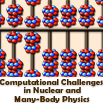Speaker
Prof.
Mike Guidry
(University of Tennessee and Oak Ridge National Laboratory)
Description
Superconductivity and superfluidity having generically recognizable features
are observed or suspected across a strikingly broad range of physical systems:
traditional BCS superconductors, cuprate high-temperature superconductors,
iron-based high-temperature superconductors, organic superconductors,
heavy-fermion superconductors, and superfluid helium-3 in condensed matter, in
many aspects of low-energy nuclear structure physics, and in various exotic
possibilities for gravitationally condensed objects such as neutron stars.
Microscopically these systems differ fundamentally but the observed
superconductivity and superfluidity exhibit two universal features: (1) They
result from a condensate of fermion Cooper pairs, and (2) They represent
emergent collective behavior that can have only an abstract dependence on the
underlying microscopic physics. This universality can hardly be a coincidence
but a unified understanding of superconductivity and superfluidity across these
highly disparate fields seems impossible microscopically. A unified picture
may be possible if superconductivity and superfluidity are viewed as resulting
from physics that depends only on broad physical principles operating
systematically at the emergent scale, with physics at the underlying
microscopic scale entering only parametrically. I will give an
overview of superconductivity and superfluidity found in various fermionic
condensed matter, nuclear physics, and neutron star systems. I will then
propose that all these phenomena result from the systematic occurrence of
generic algebraic structures for the emergent effective Hamiltonian, with the
underlying microscopic physics being largely irrelevant except for influencing
parameter values.
Author
Prof.
Mike Guidry
(University of Tennessee and Oak Ridge National Laboratory)

